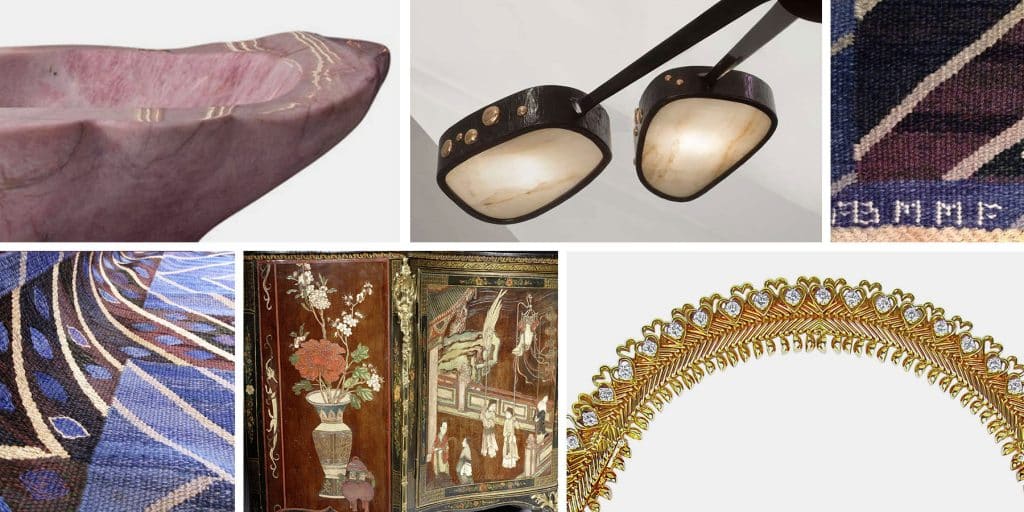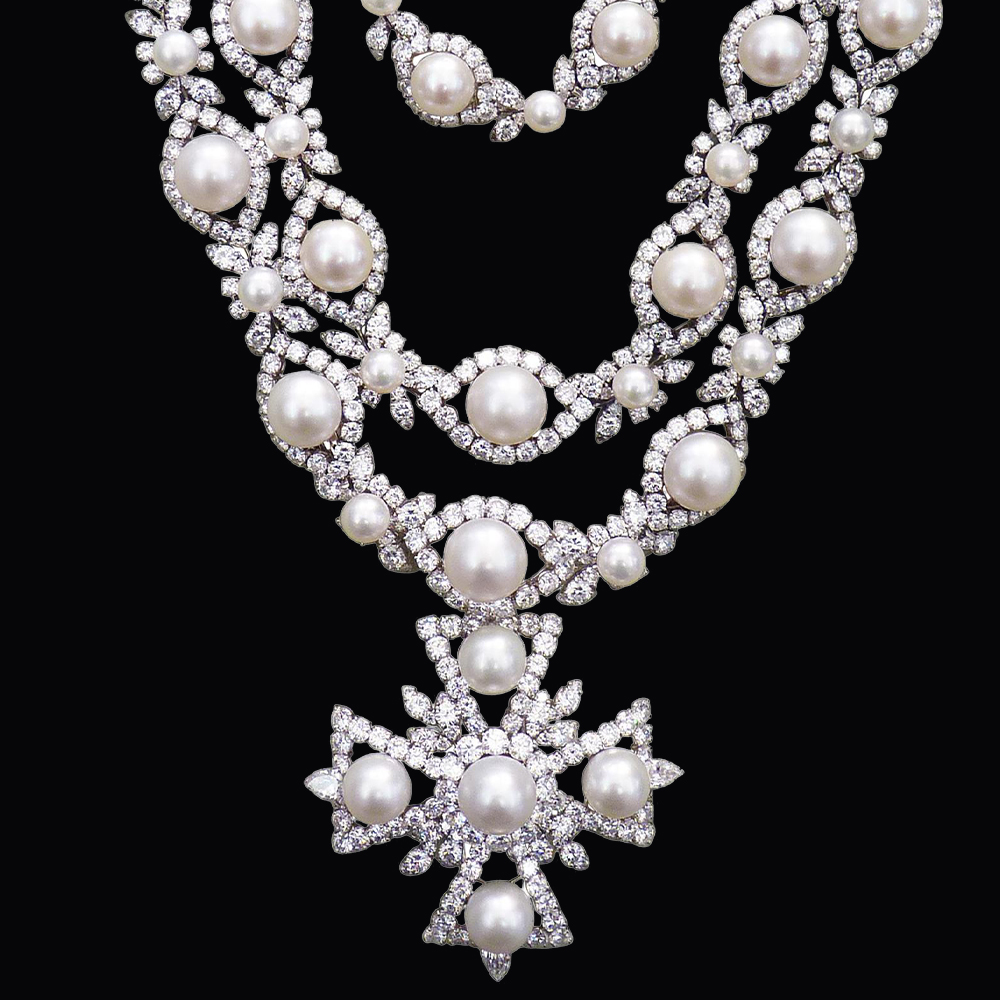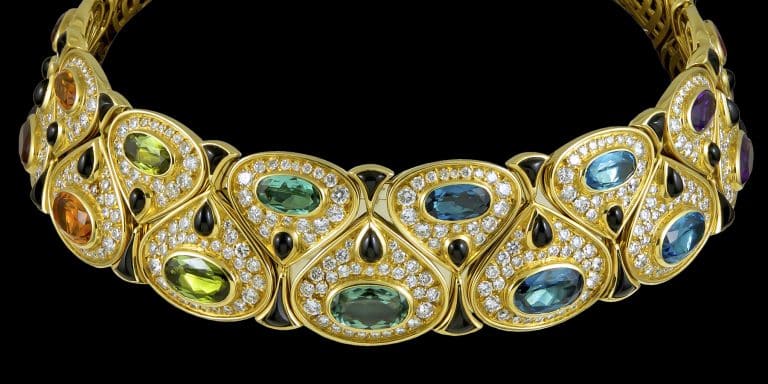Van Cleef & Arpels Zip Diamond Necklace: $750,000

August 11, 2019It took Van Cleef & Arpels more than a decade to master the design for its intricate Zip necklace, which takes up to 1,200 hours to assemble. This example was made in the 1960s.

The necklace can be fully zipped and transformed into a bracelet.
New York dealer Yafa Signed Jewels, which specializes in estate jewelry and signed vintage pieces from the Edwardian, Art Deco, retro and modern periods, has a rare Van Cleef & Arpels Zip diamond necklace from the 1960s for sale on 1stdibs for $750,000. Van Cleef has produced more than 80 of these iconic necklaces since the 1950s and continues to produce a few each year. Models created in the mid-20th century, however, tend to be the most coveted by collectors.
The design has a curious origin story. In 1938, the Duchess of Windsor had seen her friend Elsa Schiaparelli’s couture clothing incorporating zippers, giving them a Surrealist touch, and reportedly suggested to Renée Puissant, the artistic director of Van Cleef (and daughter of founder Alfred Van Cleef), that she do the same with fine jewelry. The idea was to blend humor and refinement.
We don’t know Puissant’s reaction, but we do know that when Van Cleef decided to go ahead with the idea, its realization took more than a decade. The company’s “golden hands” (skilled craftsmen) did not master the technique for producing the necklace until 1951. Making the zipper work seamlessly is a real technical achievement, with the pull on the fastener joining small gold cups on one side to similar ones on the other. The outside border is festooned with gems. Each necklace is different and requires between 400 to 1,200 hours to assemble.

Actress Margot Robbie wore a Van Cleef & Arpels Zip necklace to the Academy Awards in 2015. Photo by Jeff Kravitz/Getty Images
The design is also ingeniously versatile. When the zipper is closed, the piece can be transformed into a bracelet, with the zipper pull masking the connection point.
Van Cleef Zip necklaces do very well at auction. For example, in May 2018, Sotheby’s sold a version with sapphires, rubies and emeralds, and accented with brilliant-cut diamonds, for $510,232. Why is Yafa Signed Jewels’ piece priced at $750,000? “Our necklace is from the nineteen sixties and is very rare. The ones that are older are much more rare, special and unique and, therefore, more expensive,” explains Maurice Moradof, the firm’s founder. “I can assure you there isn’t another one like ours in the marketplace.” Moradof offers an analogy: “How can you put a price on a vintage painting that is very rare and special? There is no price.”
Achille Salvagni Octopus Chandelier: $135,000

This Octopus chandelier by Achille Salvagni, part of an edition of 20, features shades that have each been carved from a single block of onyx.
Maison Gerard, in New York, sells both exceptional vintage pieces (20th-century French Art Deco and 1940s furniture) and, increasingly, limited-edition works created by contemporary European designers. In the latter category, the gallery is currently offering on 1stdibs an Octopus chandelier, from an edition of 20 designed in 2013 by the Italian architect Achille Salvagni, for $135,000. Measuring 10 feet across, the fixture has eight arms, in different lengths, fanning out from the base. It is made of both polished and gunmetal patinated bronze, with translucent onyx shades.

Achille Salvagni is also an architect with a 30-person firm that specializes in the design of private residences and superyachts. Portrait by Giovanni Malgarini
“This is one of Salvagni’s most iconic pieces,” says Benoist F. Drut, the owner of the gallery, which has been representing the architect since 2013. “It’s a feat of engineering, of checks and balances.”
Salvagni was born in 1970 in Rome and trained as an architect. In 2002, he formed Salvagni Architetti, today a 30-person multidisciplinary firm specializing in the architecture and interior design of private residences and superyachts. What distinguishes him from his peers is his insistence on designing nearly every piece in his projects — furniture, lighting, carpeting and works of art, all made using only the finest materials: bronze, exotic woods, onyx and sumptuous textiles.
Over the years, he has commissioned small workshops across Italy that employ master craftsmen to fabricate his creations. “The Octopus light fixture is made in Rome by bronze workers who have been serving the Vatican for generations,” Drut says.

Maison Gerard, which has represented Salvagni since 2013, is offering the Octopus chandelier for sale on 1stdibs. “It’s a feat of engineering, of checks and balances,” Maison Gerard owner Benoist Drut says of the piece.
Salvagni likes to challenge the skilled artisans who craft his pieces, asking them to employ their age-old skills in novel, unorthodox ways, and they seem to relish the opportunity. For the chandelier, for example, Salvagni specified that each shade be made not of a thin slice of onyx, which would be standard, but of a solid one-inch slab carved from a single block of stone.
Drut acknowledges that the chandelier is not the most “affordable” creation. And a client must have room for its 10-foot span. Still, this is design couture.
Marianne Richter Rug: $105,000

Swedish textile designer Marianne Richter created flat-weave rugs for the Märta Måås-Fjetterström factory. This example, which is being offered by Peter Pap, stands out for its large size and complicated design.
New Hampshire rug dealer Peter Pap, who has been in business for more than 40 years, is offering on 1stdibs a fine, large, colorful flat-weave rug by Marianne Richter, among the foremost textile designers of the 20th century.
The Swedish Richter (1916–2010), who also worked in ceramics, designed flat-weave woolen carpets for her country’s diplomatic corps and woven curtains for the Economic and Social Council Chamber at the United Nations. She took over leadership of the Märta Måås-Fjetterström factory after its founder’s death, in 1941. In 1955, she took on an additional job, designing more moderately priced rya rugs at AB Wahlbecks Fabriker.

Marianne Richter, who also worked in ceramics, took over leadership of the Märta Måås-Fjetterström factory after its founder’s death, in 1941. Photo courtesy of Märta Måås-Fjetterström
“It’s a premier example of Marianne Richter’s mid-century modern design work at the Märta Måås-Fjetterström factory,” Benjamin Banayan, a researcher at Peter Pap’s San Francisco branch, says of the rug. “Normally pieces made at that factory are not as big, as detailed, nor signed, nor given a title.”
This rug, which measures 14 by 20 feet, has woven into it the initials of both the designer, Marianne Richter, and the factory, MMF, which is still Sweden’s foremost atelier for hand-woven art textiles, rugs and tapestries. “And it is one of the very few rugs that was given a title: Blue Rays,” Banayan says.
This year, MMF is celebrating its 100th birthday in Båstad, Sweden. Rugs from the Swedish royal collection will be displayed at the Royal Palace in a show opening on October 13. The factory’s creations are also in the collections of the Louvre; Victoria and Albert; Nationalmuseum, in Stockholm; Cooper Hewitt, Smithsonian National Design Museum; and the Metropolitan Museum of Art, which curated a show on MMF in 1937.
“She is known primarily for her use of color,” Pap says of Richter. “Here she has alternated diamond and quatrefoil forms in blue and violet against a lattice of dark and light striped shades.” Flat-weave rugs are all hand crafted, so they’re incredibly labor intensive, especially this example, which has a complicated design. “It is a tour de force of weaving,” Pap notes.

“Here she has alternated diamond and quatrefoil forms in blue and violet against a lattice of dark and light striped shades,” Peter Pap says of Richter’s design.
Why is it priced at $105,000? “We’ve carried other MMF works, but this one is important for its scale, the monumentality of the design and its complicated technique,” Banayan says. “Its texture is also a cut above. This is not a plain tapestry flat-weave carpet.”
Moreover, it dates to 1949, when Richter was in charge of the workshop, and is in fine condition. At auction, pristine early MMF rugs have sold for as much at $215,000.
This example also has a solid provenance: The late New York rug dealer F.J. “Joe” Hakimian sold it 25 years ago for $85,000. He once said he saw the prices of MMF rugs jump 10-fold in 30 years.
Baldi Firenze 1867 Hand-Carved Rose Quartz Bathtub: $1.13 million

This bathtub by Baldi Firenze 1867 was hand carved out of a single slab of rose quartz from the Amazonian rainforest.
Italian impresario Manfredi Moretti represents not opera stars but also skilled artisans who work in glass, ceramics, marble and jewels, creating fashion and contemporary lighting and furniture. The creative director of Manfredi Style, which he founded in 2013, Moretti is based in Florence, Singapore and New York but sells to clients all over the world (he is particularly popular in Dubai) at fairs, in showrooms and on 1stdibs, where he is currently offering a hand-carved rose quartz bathtub for $1.13 million.

It took a team of craftspeople six months to sculpt and polish the tub by hand.
Baldi Firenze 1867 — a company founded in 1867 that specializes in carving what it calls “home jewels” — fabricated the tub, which has a rough exterior, almost like a rock ledge, and a polished, smooth interior.
The multiton block of rose quartz was mined and acquired in South America and imported to Carrera, Italy, where Baldi has its workshops. As general manager Leonardo Boni (a sixth-generation member of the Baldi family business) explains, “Sixty years ago my grandfather established a warehouse and workshop there, because it was near a port and next to the marble quarries.”
To make these tubs, Baldi employs a team of veteran Florentine designers to study the stone from both an aesthetic and a technical point of view. Another team then sculpts and polishes the tub by hand, which takes six months. The result, of course, is unparalleled.
“I collaborate with designers and artists from all over the world, from Italy but also the Ukraine, Japan, England and America,” Moretti says. “I select every item personally. I call the pieces ‘emotional creations.’
“Florence is the city of the Renaissance,” he adds. “It has given life to many art movements. We have a lot of beautiful things in our lives here. My job is to research and find more beautiful things.”

After the block of rose quartz was mined, it was imported to Baldi’s workshops in Carrera, Italy.
George III Coromandel Serpentine Commode: $557,530

This George III Coromandel lacquer serpentine commode is being offered for sale on 1stdibs by Frank Partridge, who attributes it to Pierre Langlois, a Paris-trained Huguenot cabinetmaker.
By-appointment London dealer Frank Partridge is selling a George III serpentine commode on 1stdibs that is exceptional in its rarity, style, provenance, materials, craftsmanship, condition and attribution. It’s also particularly handsome: The curved doors in front are carved scenic panels taken from an antique Coromandel screen. These screens, having 12 folds and created using a type of lacquer that originated in southern China, were prestige items in 17th-century China, often produced as gifts for high-ranking officials. By 1688, however, they had gone out of style in that country and were being exported to England and Continental Europe, where they were considered the height of fashion until the 1770s.
The commode’s carved panels show Chinese dignitaries in the forecourt of a palace. Their attendants hold lanterns and standards aloft on poles. The sky above is filled with cloud-swirl motifs. The sides of the commode are decorated with panels depicting peacocks, a crocodile and prunus flowers. Three deep drawers with mahogany fronts are revealed when the lacquer doors are opened.

The commode’s front panels show Chinese dignitaries and their attendants, and the side panels show prunus flowers, peacocks and a crocodile.
Partridge attributes the commode to Pierre Langlois, a Paris-trained Huguenot cabinetmaker who established a business in London around 1759. Langlois (whose name is French for “the Englishman”) had fashionable clients, including Horace Walpole, the fourth duke of Bedford and the Earl of Coventry.
This particular commode was made about 1760 for Sir John Goodricke (1708–89), the 9th Earl of Carlisle, of Ribston Hall in Yorkshire. Through family inheritance, it descended to relatives of Baronet Howard of Henderskelfe and spent most of the 20th century at Castle Howard, one of the grandest country houses in England. The Howard family sold it at auction in 2002 after a divorce.
Royal palace furniture in France normally has an inventory mark and, often, a tax number on the gilt brass mounts. This commode, being English, has neither.
“Langlois never signed his pieces, but we know it’s by him because it has so many Langlois features, including the fact that its back is painted and it has a marquetry top,” Partridge explains. (The backs of antique furniture are rarely finished or painted, and the French preferred marble tops.)
“Langlois worked in the French style,” he continues, noting the virtuosity required to bend wood to make a serpentine front.

The curved doors of the commode, which was made in about 1760 for Sir John Goodricke, open to reveal three drawers with mahogany fronts.
Finally, Langlois married the daughter of Dominique Jean, who settled in England before 1760, and the dealer believes Jean supplied the stunning brass mounts.
“There are only about six other commodes in Coromandel lacquer that are known to have been made in the eighteenth century in England, and all of them were by Langlois,” says Partridge, who years ago sold another example to the Victoria and Albert. “Not only do we have all the Coromandel lacquer on this commode, but we have all the original gilt brass mounts as well.”
The best examples of antique English furniture command high prices. Why $557,530 for this one? “It’s a sensational piece of English furniture,” the dealer says. “It has everything. It ticks every single box. You simply can’t fault it.”


